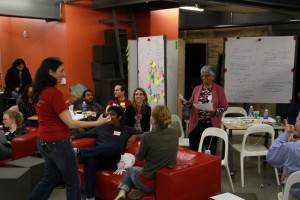To explore ways to solve the pain points of undergraduate engineering students, the Epicenter hosted a design challenge workshop as part of Stanford University’s Entrepreneurship Week activities. The goal was to use the design thinking process as a pathway to understand engineering student needs when it comes to becoming more entrepreneurial and innovative.
Epicenter Associate Director Leticia Britos Cavagnaro facilitated the workshop, leading the more than 30 participants through key phases of the design thinking process: user empathy, problem definition, ideation, solution prototyping and testing. Workshop attendees included university faculty and students, as well as members of the community including industry representatives with a particular interest in this area.
“It was fantastic to ‘walk in the user’s shoes’ during the Epicenter design challenge and to re-think ways on equipping engineers with a designer’s mindset,” says Frederik Pferdt, Global Program Manager for Innovation and Creativity at Google.
During the empathy and problem definition phases, workshop teams interviewed undergraduate engineering students from local colleges and universities, learning about their experiences and challenges. One challenge for many students was keeping up in such a rigorous academic field, while still finding time to access entrepreneurship mentors and resources.
Once real problems confronting today’s engineering undergraduates were defined, workshop teams began the activity of ideation, in an attempt to generate possible solutions. In this stage of the process, the role of divergent thinking becomes vital.
“If a team is tasked with solving a problem, the classic response is to go with the first right answer that seems sensible to the group,” says Epicenter Director Dr. Tina Seelig. “However groups need to use divergent thinking to generate as many solutions as possible to get past the obvious choices.”
From the large collection of solutions generated during the ideation phase, teams eventually selected one idea to physically prototype and test. In the first stage of low resolution prototyping, this means an idea for a bus full of technology tools and industry mentors is created from cardboard and pipe cleaners, and a smartphone application for entrepreneurial advice is built out of layers of sticky notes.
During the testing phase the prototypes were presented to the undergraduate engineer originally interviewed during the empathy stage. While some solutions were funny and others right on point, the real success was found in the impact on the student interviewees, who appreciated each team’s dedication to trying to solve a central problem in their lives.
While many people think engineers are only entrepreneurial if they launch and market products, design thinking is a process that helps engineers develop a broad range of entrepreneurial skills that complement their technical training.
According to Britos Cavagnaro, “We need engineers that have skills to lead creative teams and work across all disciplines to envision impactful solutions for the world’s complex problems.”





